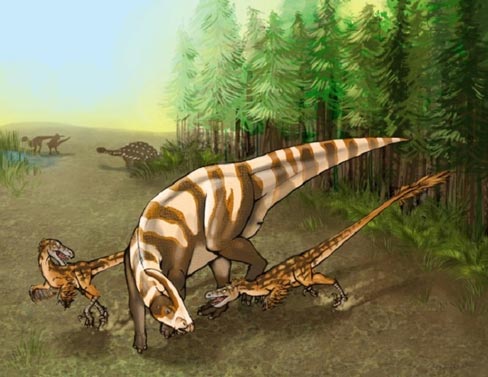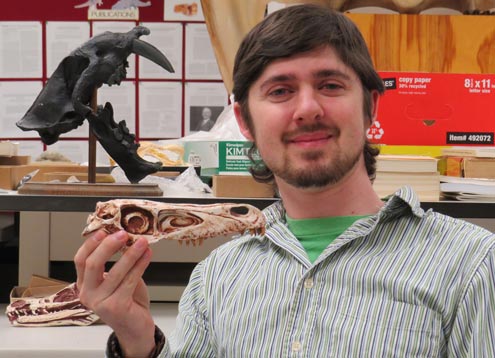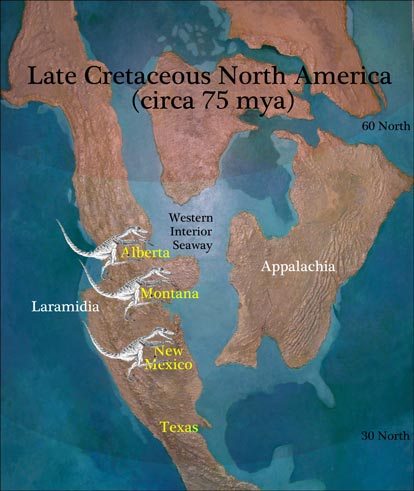Sniffing Out a New Dinosaur Species
Saurornitholestes sullivani – Don’t Turn Your Nose Up When It Comes To The Dromaeosaurids
Steven Jasinski, a PhD student at the University of Pennsylvania (Department of Earth and Environmental Science), has identified a new species of North American dromaeosaur, one that may have had a very keen sense of smell. Saurornitholestes sullivani was not the largest predator known from that ecosystem, but with its sharp senses, grasping arms, turn of speed, large claws and jaws full of dagger-like teeth it was very probably a formidable hunter.
Saurornitholestes sullivani
Steven made the discovery whilst studying cranial elements (skull fossils) that had been assigned to the genus Saurornitholestes but to another species, (S. langstoni). Up until now, Saurornitholestes langstoni was the only species assigned to this genus, now there are two. This is yet another example of a new dinosaur species being erected from a reassessment of previously described fossil remains. The Saurornitholestes genus was established in 1978, following the description of a partial skeleton discovered in Alberta (Canada). Although, no complete or near complete fossil specimen has been found to date, fossil material from both the Judith River Formation (Montana) and the Dinosaur Provincial Park Formation (Alberta) have been assigned to this genus.
The huge number of broken teeth found, indicate that this dinosaur was probably one of the most common predators in this part of North America approximately 75 million years ago (Campanian faunal stage).
An Illustration of a Pair of S. sullivani Attacking a Juvenile Parasaurolophus
Picture credit: Mary P. Williams
The picture above depicts a pair of feathered dinosaurs attacking a juvenile duck-billed dinosaur.
A Feathered Dinosaur
Although no evidence of feathers have been found preserved alongside fossil material assigned to this genus, it is likely, that this small, agile dinosaur was feathered. A report on Saurornitholestes sullivani has been published in the New Mexico Museum of Natural History and Science bulletin.
The fossil material was originally found by American palaeontologist Robert Sullivan in 1999, when a field team was exploring the Bisti/De-Na-Zin Wilderness in northern New Mexico. The fossils were initially described as Saurornitholestes langstoni and represented the southernmost location for this species.
Differences in Skull Anatomy
However, Steven Jasinski conducted a comparative analysis of these fossils with those of S. langstoni from Montana and Alberta and he observed a number of differences in skull anatomy. When the brain shape and volume was calculated, the student noted that the proportion of the brain dedicated to interpreting and analysing smells was unusually large. The enlarged olfactory bulb indicates that this two-metre-long dinosaur had a powerful sense of smell.
Jasinski commented:
“This feature [enlarged olfactory bulb] means that Saurornitholestes sullivani had a relatively better sense of smell than other dromaeosaurid dinosaurs including Velociraptor, Dromaeosaurus and Bambiraptor. This keen olfaction may have made S. sullivani an intimidating predator as well.”
Steven Jasinski Holding a Replica of the Skull and Upper Jaw of S. sullivani
Picture credit: University of Pennsylvania
The picture above shows Steven holding a replica of the fossil material, the large eye socket (orbit) also suggests that this little hunter had keen eyesight.
Saurornitholestes sullivani from Southern Laramidia
At the time S. sullivani lived, North America was split into several parts separated by an inland sea (the Western Interior Seaway). This dinosaur lived on the landmass known as Laramidia. S. sullivani represents the only named dromaeosaur from the Late Cretaceous of southern Laramida, but the wealth of micro-fossil evidence, consisting of broken teeth suggests that there may have been several different species of dromaeosaur inhabiting the floodplains on the eastern shores of Laramidia.
Although a distinct species, Saurornitholestes sullivani was very closely related to S. langstoni. Finding two distinct species of this genus hundreds of miles apart supports the hypothesis that distinct but closely related megafaunal communities existed on Laramida (supporting the concept of ethnicity within the Dinosauria of Late Cretaceous North America).
Approximate Location of Saurornitholestes Fossil Material from Laramidia
An Exceptional Sense of Smell
Having an exceptional sense of smell would have helped this agile dinosaur to sniff out potential prey. Although, in the illustration above Saurornitholestes is depicted attacking a duck-billed dinosaur, it may not have hunted large prey. The sense of smell could have helped this dinosaur, that probably measured around one metre high at the hips, to sniff out mammals living in burrows or to find lizards and other small creatures in the undergrowth. In addition, an acute sense of smell could have helped Saurornitholestes find carrion that it could then scavenge.
The Beasts of the Mesozoic series of articulated models includes Saurornitholestes figures: Beasts of the Mesozoic Articulated Models.




